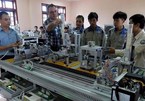“There should be two schools in vocational training. One school is the lecture hall, the other is enterprise,” the Minister of Labor, War Invalids and Social Affairs Dao Ngoc Dung said at the signing ceremony of the cooperation agreement between the Vocational College of Agricultural Mechanics and enterprises, under which the parties committed to join forces to produce 21,500 skilled workers in 2020-2025.

The lack of skilled workers is a big challenge to enterprises globally, including Vietnam. Dung said many employers think that the labor force in Vietnam is abundant, but in fact, enterprises are now complaining that they are finding it difficult to recruit workers.
“With the current aging rate of the Vietnamese population, the labor force is starting to be in short supply,” he commented.
| A report showed that in 2017-2018, 2.2 million students were enrolled in vocational education. This included 540,000 students for junior colleges (3-year training) and intermediate school (2-year training). |
Fortunately, in recent years, local authorities have been providing training in many professions. If not, rural areas would not be able to retain laborers and the movement of laborers leaving rural areas for large cities or abroad would be even stronger.
Dung said MOLISA, when compiling the amended version of the Labor Code, heard complaints from enterprises about the lack of skilled workers. Enterprises should understand that they need to join forces with schools to prepare the labor force.
“Cooperating with the school is an opportunity. The beneficiary in the cooperation, in long term, is enterprises,” he said.
Meanwhile, for the school, it needs to produce 21,500 workers within five years. The school needs to join forces with every enterprise to check and amend training curriculums to make them fit every type of business and produce the workers who meet the new requirements in the 4.0 era.
Dung thinks that enterprises need to get involved in the training process. They need to participate in teaching and curriculum development. Meanwhile, students need to have more opportunities to spend practice hours at enterprises.
The minister, for the first time, mentioned the concept of ‘two schools’ in vocational training.
“Apprenticeship is different from academic learning. With academic learning, students mostly receive knowledge at schools. Meanwhile, with apprenticeship, students mostly access knowledge at enterprises,” he said.
In Germany, theoretical study only accounts for 30 percent of total vocational training time, while 70 percent of time is reserved for practice hours. Vietnam will go that way.
A report showed that in 2017-2018, 2.2 million students were enrolled in vocational education. This included 540,000 students for junior colleges (3-year training) and intermediate school (2-year training). Meanwhile, the other 1.6 million students were in elementary level training and short-term training courses.
Mai Lan

Vietnam lacks workers with vocational training skills
Vocational schools complain they are finding it difficult to enroll learners despite attractive job opportunities.

At least five vocational schools of Vietnam set to meet G20 standards
A total of 70 vocational schools are expected to be recognised as high-quality establishments during the 2025-2030 period, with at least five satisfying the standards set by the group of developed nations (G20).
 The lack of skilled workers is a big challenge to enterprises globally, including Vietnam.
The lack of skilled workers is a big challenge to enterprises globally, including Vietnam.